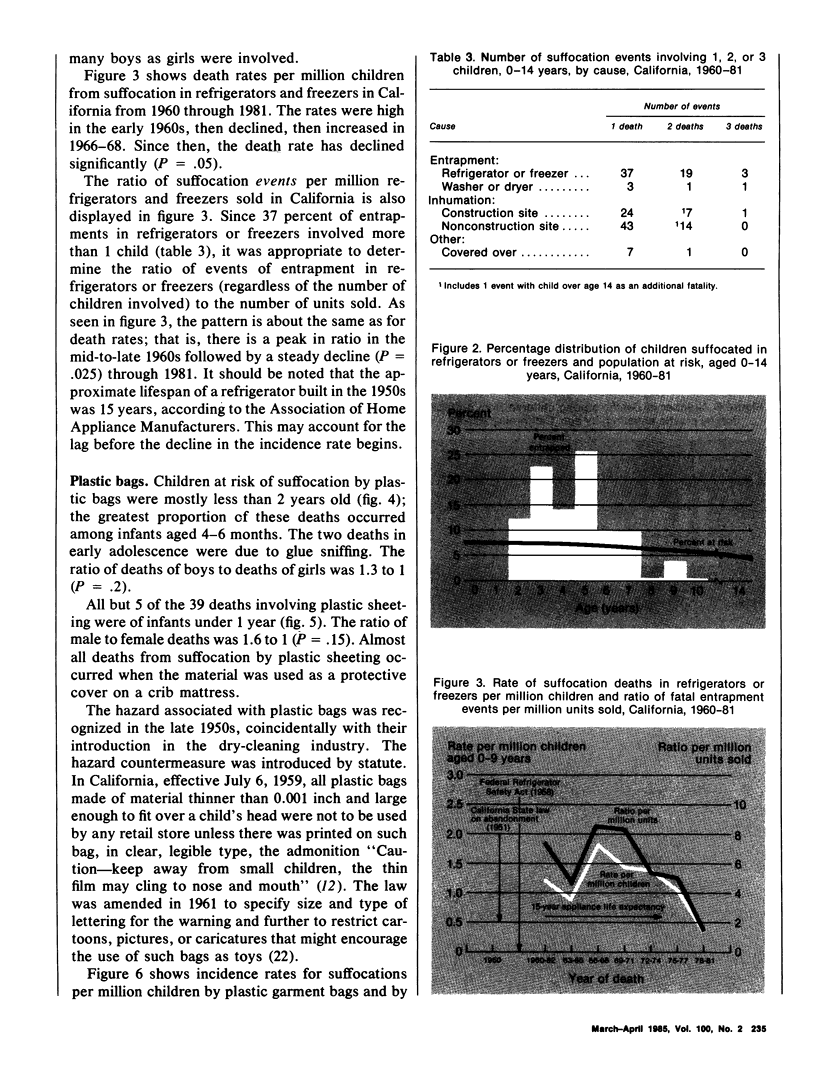Abstract
Unintentional deaths from suffocation and strangulation account for about 20 percent of all nontransport-related infant and child fatalities in the United States. In the late 1950s, some preventive countermeasures were introduced to reduce the number of deaths resulting from refrigerator or freezer entrapment. A few years later, countermeasures were introduced to prevent deaths resulting from suffocation by plastic bags, inhumation, and mechanical strangulation from wedging in infant cribs. For three of these major causes of suffocation and strangulation deaths among infants and children (refrigerator or freezer entrapment, suffocation by plastic bag, and inhumation at construction sites), there appears to have been a significant decline in incidence; however, there is no evidence of a significant reduction in deaths from mechanical strangulation in cribs. The impact of current countermeasures is discussed, and some suggestions for new or modified approaches are made.
Full text
PDF









Selected References
These references are in PubMed. This may not be the complete list of references from this article.
- BAIN K., FAEGRE M. L., WYLY R. S. Behavior of young children under conditions simulating entrapment in refrigerators. Pediatrics. 1958 Oct;22(4 Pt 1):628–647. [PubMed] [Google Scholar]
- Baker S. P. Childhood injuries: the community approach to prevention. J Public Health Policy. 1981 Sep;2(3):235–246. [PubMed] [Google Scholar]
- Barry P. Z. Individual versus community orientation in the prevention of injuries. Prev Med. 1975 Mar;4(1):47–56. doi: 10.1016/0091-7435(75)90053-5. [DOI] [PubMed] [Google Scholar]
- Bass M. Asphyxial crib death. N Engl J Med. 1977 Mar 10;296(10):555–556. doi: 10.1056/NEJM197703102961008. [DOI] [PubMed] [Google Scholar]
- Bergeson P. S., Hernried L. S., Sonntag P. L. Infant strangulation. Pediatrics. 1977 Jun;59 (Suppl)(6 Pt 2):1043–1046. [PubMed] [Google Scholar]
- Bulugahapitya D. T., Beck P. R., Lobo S. Near-fatal asphyxia by a toy shopping bag. Br Med J (Clin Res Ed) 1982 Jul 24;285(6337):263–263. doi: 10.1136/bmj.285.6337.263. [DOI] [PMC free article] [PubMed] [Google Scholar]
- DANGER of suffocation from plastic bags. J Am Med Assoc. 1959 Aug 1;170(14):1667–1668. [PubMed] [Google Scholar]
- Feldman K. W., Simms R. J. Strangulation in childhood: epidemiology and clinical course. Pediatrics. 1980 Jun;65(6):1079–1085. [PubMed] [Google Scholar]
- Haddon W., Jr Editorial: Strategy in preventive medicine: passive vs. active apprroaches to reducing human wastage. J Trauma. 1974 Apr;14(4):353–354. [PubMed] [Google Scholar]
- JEFFREY F. W. Death from plastic film. Can Med Assoc J. 1959 Oct 15;81:687–688. [PMC free article] [PubMed] [Google Scholar]
- Polson C. J., Gee D. J. Plastic bag suffocation. Z Rechtsmed. 1972;70(3):184–190. doi: 10.1007/BF02116314. [DOI] [PubMed] [Google Scholar]
- Rivara F. P., Bergman A. B., LoGerfo J. P., Weiss N. S. Epidemiology of childhood injuries. II. Sex differences in injury rates. Am J Dis Child. 1982 Jun;136(6):502–506. doi: 10.1001/archpedi.1982.03970420026004. [DOI] [PubMed] [Google Scholar]
- Sinal S. H., Stanton W. A. Infant strangulation in a mesh portable crib. Pediatrics. 1979 Apr;63(4):669–670. [PubMed] [Google Scholar]
- Smialek J. E., Smialek P. Z., Spitz W. U. Accidental bed deaths in infants due to unsafe sleeping situations. Clin Pediatr (Phila) 1977 Nov;16(11):1031–1036. doi: 10.1177/000992287701601113. [DOI] [PubMed] [Google Scholar]
- Sturner W. Q., Spruill F. G., Smith R. A., Lene W. J. Accidental asphyxial deaths involving infants and young children. J Forensic Sci. 1976 Jul;21(3):483–487. [PubMed] [Google Scholar]


